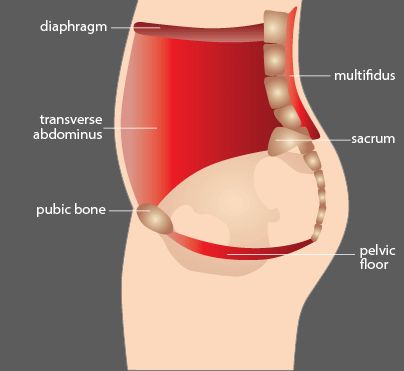Pelvic floor in pregnancy and child birth
Often women and new mums in particular only learn about the pelvic floor and it’s function when there already is a difficulty. Research shows being aware and “exercised” can prevent difficulties, improve labor and recovery. A muscle group so important, it deserves no less attention than a birth plan or preparation for new arrival.
What is pelvic floor and its function?
This group of muscles fills in the space at the bottom opening of your pelvis (pelvic ring bones). It essentially provide “the floor” that is supporting all inner organs, including reproductive organs and is holding the baby during pregnancy.

These muscles function in team with deep abdominals (core ) muscles which represents “the cylinder” and diaphragm that can be seen as roof of the cylinder. In order to support spine, posture and inner organs, these muscles needs to work in together. If the pelvic floor is weakened, too tight or cannot contract/relax effectively, the whole body support system can get affected. Pelvic floor muscles play key role in bowel and bladder control as well as sexual function. Dysfunction of pelvic floor can also have direct or indirect effect on movement of pelvis and the legs.
Improving/maintaining good function of pelvic floor.
The first step is to be aware and treat pelvic floor like any other muscle. Its function need to be preserved for life. Pelvic floor strengthening, stretching and relaxation exercises should be part of ones exercises routine or incorporated in/in between daily activities: e.x. every time you stop at a red traffic light.
A woman should be aware of these muscles before pregnancy, and address any concerns related to it with her health care provider. Timely assessment and treatment of pelvic floor dysfunction by a therapist or gynaecologist can save a lot of discomfort during pregnancy, birth and post-partum period.
Pelvic floor in pregnancy and birth
As baby grows, pelvic floor muscles undergo increased continuous pressure. A randomised controlled trial among 301 women in Norway showed significant shorter second stage of labor (pushing) and further disapproved the myth of strong pelvic floor obstructing labor. Pelvic floor strengthening exercises in combination with relaxation and stretch produce better control and awareness, and reduce risk of incontinence during pregnancy. During pushing stage a maximal overstretch of pelvic floor occurs (in particular levator ani) for allowing baby to pass. The ability to relax in combination with positioning of the mother can prevent further injury to the muscles.
If such injury occurs due to tear, episiotomies or instrumental delivery, recovery will be quicker when woman has improved her awareness and control of these muscles before and during pregnancy. In case of caesarean delivery pelvic floor still undergoes stress of pregnancy and will be important synergist when retraining deep abdominal muscles.
So next time you update your fitness routine, make sure pelvic floor is on the check list!
Anastasija Uvarova, Physiotherapist
